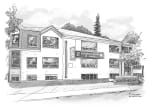Sunnybrook School THE OUR KIDS REVIEW
The 50-page review of Sunnybrook School, published as a book (in print and online), is part of our series of in-depth accounts of Canada's leading private schools. Insights were garnered by Our Kids editor visiting the school and interviewing students, parents, faculty and administrators.
Our Kids editor speaks about Sunnybrook School
Introduction
“We take pride in our small community. We’re a big small school—a hidden gem,” says Teralee Brunn, who became principal in 2018. Certainly, while there’s a lot to love, Sunnybrook School does not pretend to be anything it is not. Everyone acknowledges that it’s a small school in a fairly unassuming building. That said, for the families that enrol, it offers just what they are looking for: an intimate learning environment geared exclusively to preparing students for success in middle school and beyond. “Compared to larger schools that have to spread their resources across a much larger student body, we have a clear, strong focus on offering the best possible elementary education to our 140-odd students.”
“Everyone here knows each other,” says one Grade 4 student. “It’s not huge like some schools are. I think I know the name of every kid from Grade 1 to Grade 6.” For parents with very shy or sensitive children, or parents who balk at sending their three- and four-year-olds to school with 17-year-olds, SBS provides a warm, nurturing setting designed specifically for young learners.
The small community draws parents who want to ensure that their children aren’t overwhelmed or lost in the crowd. Most schools talk about meeting the individual needs of every child, but at a school the size of SBS, it rings true. When students start new grades, their teachers already have a good sense of who they are and what they need, having known them in previous years. The average class size is 16 to 20 students, with a 1:9 teacher to student ratio.
For some students, though, the small student body can present challenges. “Being in class with the same group of kids each year has been a problem for my daughter at times,” says one father of a daughter in Grade 6 and a son in Grade 3. “Since Grade 1, she’s occasionally had issues with the other kids. The choice of friends was somewhat limited from year to year—there just wasn’t that wide variety of kids to choose from.”
“My husband was focused on the IB Programme, but I wanted something small and intimate that would bring out my older daughter’s personality and make her comfortable despite her shyness. And it has,” says one mother of two daughters in Grade 3 and Grade 6. “She’s a confident, happy girl here.”
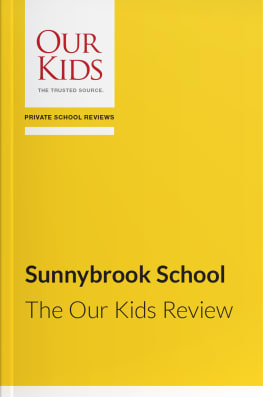
Key words for Sunnybrook School: Community. Challenge. Excellence.
Basics
SBS is a coed independent day school in Toronto, Ontario, offering the IB PYP (Primary Years Program) for Junior Kindergarten through Grade 6. It was established in 1952 and has had remarkably consistent leadership over its long life. The current principal, Teralee Brunn, recently took the reins from Irene Davy, who was director and principal for more than 30 years. There was only one director before Davy—her mother, Irmingard Hoff, who founded SBS as a preschool. While new to her role—Brunn was appointed in 2018—she too has a long history with the school, having been hired as an instructor in 1992. Brunn’s two children are alumni, and she taught multiple grades before serving as vice principal and director of admissions.
In a very real sense, the school has been a family enterprise for over 65 years, something that continues to this day and remains emblematic of the culture. Davy, remarkably, continues to oversee the life of the school—furthering a dedication to the principles her mother hoped to express when beginning SBS all those years ago. Enrolment sits at 140 students attending annually, which is small for a school in Canada. Brunn sees that as a strength and intends to maintain it. She says, “we’re going to build and improve on the existing strengths of the school, because we already have a great foundation.”
After-care is part of that foundation, something that founder Irmingard Hoff felt was critically important to supporting SBS students and their families. Children can be enrolled for the whole academic year or as needed. A Homework Studio for after-care students runs three times per week.
As a small school, the facilities and on-site athletic offerings are understandably limited, but SBS does provide something unique. When children enter the school, they join a community of peers and families who all prize what the school offers, namely an inclusive, student-centred learning environment in which all children feel known and cared for. While some students risk getting lost in the din at bigger schools, at SBS all feel that their voices are heard and their needs are promptly addressed.
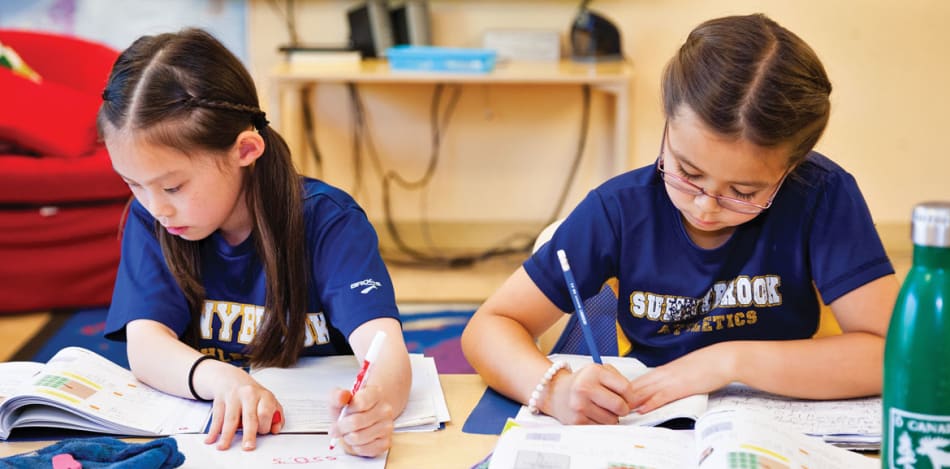
Background
At the annual Founders Day celebration each September, long-time director Irene Davy shares a story or two from the school’s history. She knows it well, because it’s also the history of her family.
Davy’s mother, Irmingard Hoff, the founder of SBS, originally planned a career in medicine in her native Austria. Her father was a prominent Viennese surgeon and her mother a pharmacist, and she hoped to continue the tradition. But with the upheaval of the war years, she was forced to leave medical studies. She pursued early childhood education instead, which proved fortuitous in the end, says Davy. “I think my mother’s real passion was always children’s education.”
In 1950, a pregnant Hoff and her husband John immigrated to Halifax, then Toronto, where there were few job opportunities in her field. Undeterred, Hoff started one of the city’s first preschools with eight students in the basement of St. Augustine of Canterbury Anglican Church on Bayview Avenue. Based on a combination of Montessori and Froebel educational approaches, it was named Sunnybrook School because of its proximity to two institutions: Sunnybrook Hospital and Sunnybrook Plaza.
In the late 1950s, the post-war baby boom was in full swing and demand for early education increased. With 40 students and a waitlist, the school outgrew the church basement by 1960. That year, with the help of some supportive parents, SBS opened the first purpose-built, privately owned nursery school in Toronto at the current location on Merton Street. The entire Hoff family—which by then included four children—moved onto the third floor, while 65 students in five classrooms occupied the lower two.
The family had to move out after just a year, however, because SBS grew so quickly. “In the 1960s, more and more women were joining the workforce, and they needed full-day care for their young children,” says Davy. “My mother expanded the hours to accommodate this need.” Hoff was a pioneer in Ontario’s daycare movement, and SBS has upheld her legacy. “We offer a seamless day, from 7:45 a.m. to 6 p.m., for every family that needs it,” says Davy.
A charming vestige of the school’s beginnings is its “tea time” tradition. Hoff’s assistant in the school’s early years was English and she instituted the ritual of serving sandwiches, milk and fruit to the youngsters at 4 p.m. To this day, the kindergarten students enjoy this small luxury. “Everybody has snack time,” says Davy. “But we have tea time.”
Over the next two decades, SBS responded to parents’ desire to keep their children at the school beyond the earliest years by first adding Grades 1 to 4. In the late 1980s, shortly after Davy became director, she phased out the preschool and added Grades 5 and 6.
“We offered an alternative to the public schools because we had small class sizes and a more rigorous curriculum,” says Davy. The school continued to grow and evolve its curriculum in response to the latest pedagogical developments through the 1990s, but she felt there was something missing. After attending a conference on the International Baccalaureate (IB) Programme, Davy knew she’d found it. In 1999, SBS became Canada’s first English-language school to implement the IB PYP, and by 2002 it was fully authorized by the IB.
Over the years, Davy became a leading figure in the IB community. She developed and led workshops for IB on three continents as part of the IB Educator Network, participated in curriculum committees for the IB PYP and is past chair of the PYP Committee for the IB.
Davy’s high-level involvement in the IB has kept SBS at the forefront of all the latest program developments. Yet it’s obvious that she’s never lost sight of her mother’s educational philosophy. “She believed that we should see children for who they are and address their needs as unique individuals, not change them to fit any particular learning structure. This is still our fundamental approach.”
The school’s early history is told in photos and words on banners near the entrance. Like the Founders Day stories, they “remind students that 65 years is a long time,” says Davy, “and that they’re part of something bigger.”
The facilities
The school is housed in an unassuming two-storey building on Merton Street, and visitors could be excused for almost driving by it. Parking is an issue, in that there really is none. There’s room for a few cars to pull up to the building on the stone frontage, but drop-off and pick-up happen at the curb, directed by staff members. Anyone who lives in a typical Toronto home with a small parking pad—or no parking at all—will be very familiar with the school’s situation. It is, after all, situated on a popular residential street in midtown Toronto and has private homes on both sides.
Yet SBS has made the most out of every square foot, both inside and out. On the day we visited, a teacher gathered his class under the linden tree adjacent to the main entrance to enjoy the warm spring weather.
Inside, the school is cheerful in all the important ways. “They’ve made the most out of this space,” says one parent, a thought echoed by several others. Our visit coincided with the weekly assembly, where students and faculty gather in the arts studio, a multipurpose space with a stage. More than 150 people attend these gatherings, and there isn’t an inch to spare. The children sit on the floor and the teachers squeeze into chairs placed around the perimeter. The overall effect is cozy, not cramped, and no one seems put off in the least by the close quarters. The wood podium, made by one of the parents and inscribed with inspirational quotes from students, adds some elegance.
Since moving out of the church basement and into its own building in 1960, SBS has been renovated and enlarged three times. The most recent addition and renovation, in 2011, was extensive. After purchasing the neighbouring property at 471 Merton, the school built four new classrooms, a locker room for senior students, and three studios for art, music and French. They are essentially large classrooms with special architectural features, like a three-tiered corner platform in the French studio and a stage in the arts studio.
That same year, SBS extended the playground area with artificial turf to provide open play space apart from the concrete basketball court and rubber-surfaced climber area. The playground, which backs onto the mature trees of Mount Pleasant Cemetery, is well-suited to the size of the student body. It doesn’t appear overcrowded, and it has plenty of room for individual groups of children to do their own thing. There’s also space for about two dozen tires—which offer the kids a classic, no-frills physical activity—and a cement tunnel, the only remaining item from the original playground.
The classrooms are all bright, with lots of windows, and feel spacious. The library was renovated in 2013 and is a colourful, inviting space despite being in the basement, where there are only half-windows. The gym is small, but the students don’t appear to mind because they use so many off-campus facilities. “We can do some cool stuff in the gym, like play scooter-board basketball,” says one Grade 6 student. “And we do other things at different places, so we don’t miss out on anything.”
As for the parents, they’re obviously aware of the limited facilities and size of SBS. But they consider it a small price to pay for the advantages of a close-knit community. “When I sent my son here, our friends and family kept saying, ‘Is there going to be enough space for him?’” says one parent of a Grade 5 student. “If there’s any kid that might not fit in a small school, it would be my kid. He’s larger than life, sporty and energetic. But we haven’t had an issue with that. They bus them out to bigger gyms and better facilities.”
The principal’s office reflects the whole place in it’s modesty, comfort and warmth. A wall of windows allows Brunn to overlook the playground. The kitchen is in the basement and the smell of a daily hot lunch wafts through the building. There’s no cafeteria for the children eat in their classrooms as Davy says, “we make it work.”
Both students and faculty feel it’s a plus, as it adds a cohesiveness within the peer groups, and otherwise avoids the din of having the entire student population in a single space.
The instructional day
Parents can drop off their children from 7:45 a.m. on, and classes begin at 8:35. Tuition includes a daily hot lunch. After-care runs from 4 p.m. to 6 p.m. In the 2021–2022 year, about 30 students attended every day.
For kindergarten students, after-care begins in the JK room with “tea time” (sandwiches, fruit and milk) and a story. They join the older children on the playground, weather permitting, or indoors at 5 p.m. Even in the winter, after-care students in Grades 1 to 6 spend at least 30 minutes outside. They may also participate in after-school clubs.
“It’s an important part of the day for some students,” says junior French teacher Julie Le Maitour, who runs the after-care program. “And it’s unique, because although I’m a teacher, it’s not a teaching environment. I get to connect with the children in a very different way. We have the same rules, but the atmosphere is lighter and less formal.” After-care also helps forge friendships across the grades, she says.
For students who need some extra academic support, or whose parents would prefer that they not bring work home, there’s the homework studio, which is available to all regular and occasional after-care students. “It’s completely voluntary, though sometimes parents or teachers will encourage a student’s participation,” says Le Maitour. “But the idea is that the students want to be there.”
Special celebrations, big and small, are frequent and often involve the whole school community. On Poem in Your Pocket Day, for example, every student and staff member have just that. Other in-school events include Founders Day, the annual Spelling Bee and Geography Challenge, and author visits.
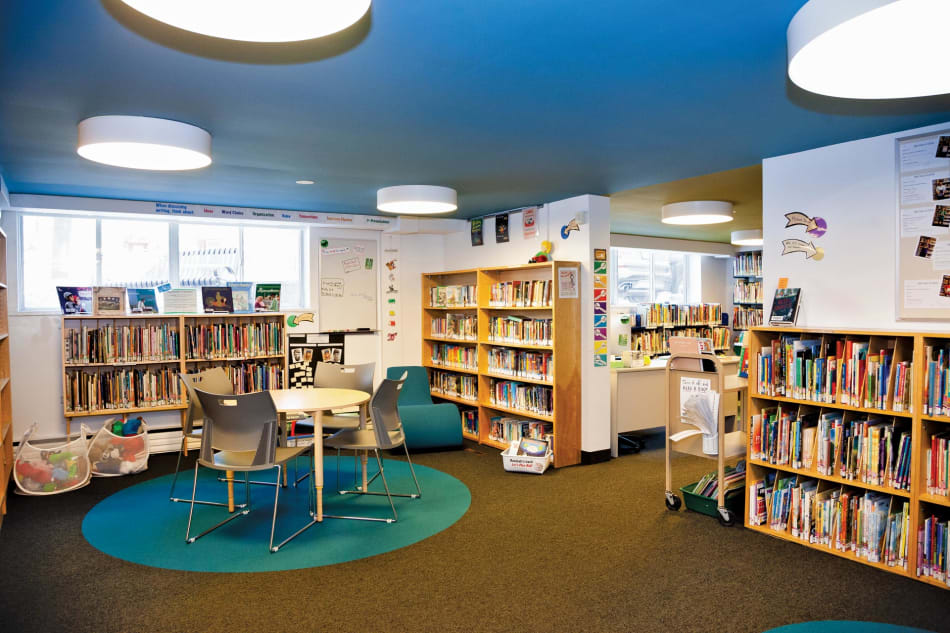
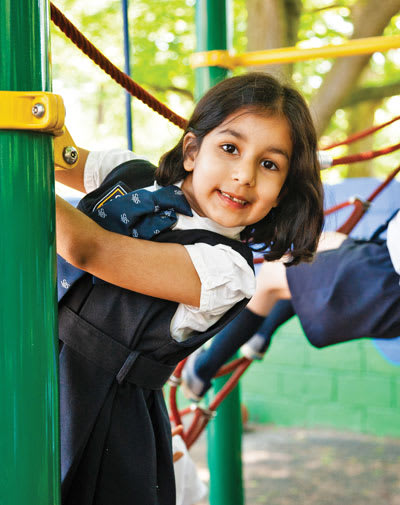
Student population
With 140 students from JK to Grade 6, there’s just one class per grade. Looking at the whole student body gathered for the assembly, it’s evident that the population reflects the diversity of the city it sits within. There is also a degree of socio-economic diversity, says Brunn. “Some of our parents work very hard to send their children here. We have a lot of down-to-earth families, which makes for a nice community.”
Academically, SBS students share a capacity for accelerated learning. “We look for kids who are either beyond their grade level or have the potential to be,” says Brunn. “The IB curriculum gets them to think outside the box, and not every student can do that.”
Every student entering SBS is assigned to a house named after a tree and given a t-shirt in the corresponding colour: Birch (yellow), Willow (blue), Maple (red), Oak (purple), and Pine (green). The older students in each house get a chance to hone their leadership skills, while the younger set have an opportunity to meet and learn from the “big kids.” Healthy competition among the houses is part of the SBS experience. “We get to earn points when we play house games, or when we do a really good job with our uniforms or speaking French and things like that,” says one Grade 3 student.
The school aims to create independent-minded, confident, knowledgeable learners with a broad understanding of the world, and the older students we spoke to demonstrate all those qualities. They were universally polite, eager to contribute to the discussion and seemed completely at ease speaking to an unfamiliar adult. There were a few remarks about public schools lagging behind SBS academically, which seemed motivated more by a desire to show off their school than to denigrate others, but they otherwise showed no pretentiousness.
“We get a lot of feedback that we create confident kids,” says Brunn. “Part of that comes from the way we expect every student to be part of everything we do, so every child is an athlete, musician, artist and public speaker.”
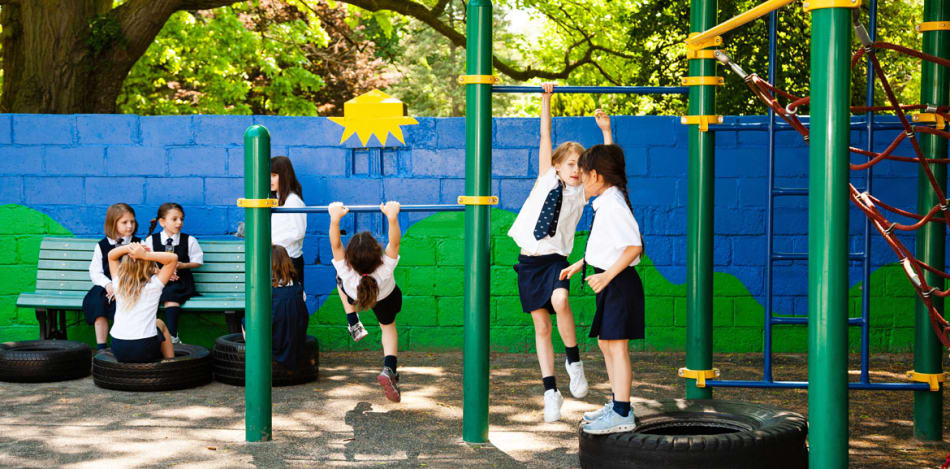
Academics
“One of the things that sets Sunnybrook apart is the faculty,” says the parent of a daughter in Grade 6 and a graduate daughter. “I’m a former teacher and I’ve worked in a lot of independent schools, and this staff is incredibly hard-working and genuine. They’re also remarkably cohesive in their belief in the IB Programme.” All the teachers have done extensive training in the IB PYP, and five are members of the IB Educators Network, which means they deliver IB workshops and conduct school visits.
With just 17 faculty members—comprising teachers for each of the grades, a music teacher, two French teachers, a phys-ed teacher and one support teacher—collaboration is easy and frequent. “I see the teachers meeting every single week to talk about the kids’ progress, curriculum themes and whatever else has come up,” says the parent of two children in Grades 3 and 6.
It wasn’t always this way, says Brunn, who started at the school in 1992. “Back then, the trend was for teachers to operate on their own little islands, implementing the curriculum in individual ways,” she says. “When we launched the IB in 1999, everything changed. Everyone suddenly had the same framework for teaching strategies, character education and assessment. We were all speaking the same language, and it brought the entire staff together. It’s almost like one big team-teaching environment.”
Director Irene Davy’s pride in, and affection for, her faculty is obvious. And she sets the bar high. Teachers are expected to keep pace with frequent curriculum updates and changes in language arts and math, while keeping the IB PYP fresh. “We’re very reflective in our practise,” says Davy. “We spend a lot of time examining what’s working and what’s not in our curriculum, and bringing in new ideas. I’m always delighted that our teachers always embrace new and better ways of doing things.”
Long tenures are the norm at the school, says Grade 2 teacher Jayne Hamilton, with an average of about nine years. To avoid any stagnation, teachers move around the grades. “The longevity of the staff plays a big part in the culture of the school. If you have a staff that really wants to be there every day, it filters through.” Says Brunn: “Irene has been a wonderful boss and treated us well. Happy teachers, happy students, happy parents.”
The happiness of the faculty—and the whole place—was a theme among the parents. “Walking in here, you pick up the energy, the happiness of the kids and teachers,” says one parent with two daughters at the school. Teachers seem genuinely proud of the school and their colleagues.
It’s obvious that the teachers not only know the students in their own class, but can walk onto the playground and call just about any student by name. It’s all part of the school’s underlying focus on cultivating a unified, close-knit community, and parents can’t say enough about it. “When your child is moving up to the next grade, their new teacher already knows them,” says one parent of a son in Grade 5 and a graduate daughter. “They hear about your child in faculty meetings, and simply by seeing them on the playground and around school all year. It gives everyone a head-start at the beginning of the year.”
Having their children truly known is critical to academic success, according to the parents we spoke to. “The faculty understand their strengths and their challenges,” says one parent of a son in Grade 2. “They support them in their learning and set them up for success based on who they truly are. My son has always been a perfectionist and is very affected by the performance of those around him. His teacher quickly recognized that and created a space where he can focus on his own work, and now he’s flying high.”
The staff is focused on understanding the differentiation in students’ needs, says Tanya Low, vice principal and director of admissions. “The teachers are always communicating and sharing strategies about what works and doesn’t work for certain students.”
Dedicated learning support, at home or at school, is available for an additional fee, with the tutors working closely with the classroom teachers. Teachers are also known to come in early to make time for students who need a bit of extra help. “When my daughter was at public school, they told us that she couldn’t read in Grade 1. They labelled her as an academic liability,” says the parent of a daughter in Grade 6 and a graduate. “It didn’t ring true to me or my husband. We knew she was bright. Coming to Sunnybrook changed the trajectory of her life. They don’t give up on kids here. They find everybody’s strengths. She’s now at Branksome Hall and has a 97% average.”
One boy in Grade 6, who came to SBS in Grade 3 from the public system, echoes this conviction. “I learn everything so much faster here. I think it’s because of the way they teach, and the way they push us to our limits, but not too hard. They adapt to how we learn and use that.” Says another boy in Grade 3: “Before I came here I was the worst in my class in math. Now I’m one of the best.” How did that happen? “They take lots of time to explain stuff, and they tell you what you did a good job on first, then how you can improve.”
Teachers are supposed to care (or at least appear to), but all evidence at SBS points to a genuine concern for students’ well-being and success. “Our faculty members are keen to be good educators in every sense,” says Davy. “We’re never dragging anybody along. We all want Sunnybrook to be the best school it can be.”
Educational philosophy
Classrooms are called “studios” at SBS—a reflection of the school’s active, creative approach to learning through the IB PYP. Davy herself coined the term. “It’s meant to be a more expansive word that shows these spaces are meant for collaborating, exploring, inventing and building—not just sitting at desks,” says Low. Walking the halls and peeking into each classroom shows this to be true, as most rooms are alive with activity, small-group discussion and, in one room, the intricate process of making colourful sand mandalas (an ancient Buddhist art form) on the tables.
According to the school’s inquiry-based, constructivist philosophy, students create their own meaning and knowledge by exploring concepts, asking questions and acquiring skills. “We allow the kids to develop their own curiosity and pursue a love of learning through inquiry,” says Mike Rossiter, vice principal, IB coordinator and Grade 6 teacher. “There’s a balance between teacher-guided inquiry and independent inquiry. The older they get, the more independence they get.”
Yet there’s no lack of structure or foundational skills here. The key word, repeated often by teachers and parents, is balance. The goal is to achieve an equilibrium between instilling emerging, 21st-century skills of global citizenship and ensuring a solid underpinning of essential competencies in numeracy and literacy.
“We’re intentional about preserving the basics while staying current, because it can be very easy to get caught up in the flavour of the day in education,” says Davy. “Students need to learn how to handle the dynamics of group work, for example, but they should be able to sit quietly and work on their own too. It also applies to balancing busy academic time with outdoor time, and technological teaching methods with traditional teaching methods.”
There’s a one-to-one iPad program for every student, yet they also teach D’Nealian handwriting starting in junior kindergarten. “Our students know how to use a pencil and paper, and we have 13,000 books on the library shelves,” says Brunn. “We’re tech-savvy, but we haven’t thrown out any of the fundamentals.”
Most parents extol the benefits of cursive writing for quick, efficient note-taking in the later years, though whether there’s any need for that is up for debate. The school hallways have students’ handwriting on full display, from the kindergarten students’ single sentences under pictures to page-long expository writing samples in the upper grades. Not every student takes to the practise. “My daughter is still not into handwriting,” says one parent of a daughter in Grade 6. “She always reverts to her iPad because it’s much faster for her.”
The iPads support the IB PYP in many ways, such as by facilitating the students’ inquiry on various subjects with online research and allowing them to create “portfolios”—which can include videos—of their learning. “We basically create eBooks on our iPads of our schoolwork,” says one Grade 4 student. “We usually end up with about 30 pages in our portfolio for each unit of inquiry.”
Digital citizenship is part of the curriculum, and the teachers collaborate with the librarian to ensure students learn both traditional and online research methods. “We’re very cognizant of the concern about kids’ screen time, and we make sure the iPads are used as production or creative tools,” says Rossiter. “We teach them ‘app smashing,’ where they use multiple apps to create different content and bring it all together.”
While most parents seem assured that the school is creating the right balance between digital and traditional learning, one parent, a software engineer, is less convinced. “I’d prefer a little bit less technology at school,” he says. “I think it’s something that could be learned later. If you start too young you can get into bad habits.”
Jen Mactaggart, the teacher librarian, says it’s a continual balancing act. “There are moments where we can tip too far one way with technology, but we’re always adjusting and correcting. My daughter graduated from Sunnybrook last year, and I feel she had a very balanced education. It’s rare, these days.”
The small faculty is always reflecting on the efficacy of the current curriculum and considering new evidence-based approaches. “We take a growth mindset, just like we encourage the students to do,” says Low. To guide this approach, the school produces a five-year vision statement. The SBS vision has three foci: Student Agency and the IB PYP Enhancements, which allows students to have more ownership over their learning; Social Emotional Learning which is the process through which children acquire and effectively apply the knowledge, attitudes, and skills necessary to understand and manage emotions, set and achieve positive goals and relationships; and technology, which will prepare students to be digitally literate and learn basic coding skills.
“Every part of our curriculum puts the learner at the centre,” says Low. “From there, we try to create a balanced, holistic education that’s inherently enriched.”
Curriculum
“I see the results of the curriculum every day in the questions my son asks me,” says one parent of a Grade 2 student. “The inquiry-based method makes him think, and he makes me think.”
The IB PYP forms the backbone of the curriculum, providing a common framework centred around broad, transdisciplinary themes such as “Who We Are,” “Where We Are in Place and Time,” “How the World Works” and “Sharing the Planet.” To explore these themes, SBS developed an inquiry-based program with specific content—updated and revised annually—for each grade level. The PYP Programne of Inquiry holds the content for science, history, geography and social studies, as well as applications of language arts, math and the arts. This year, for example, within the “How the World Works” theme, the Grade 2 students investigated structures around the globe, while Grade 5 students examined the properties of energy.
Students across the grades are well-versed in the vocabulary of the IB Learner Profile. The profile sets out ten desired “dispositions” of an IB PYP learner: Thinkers, Communicators, Risk-takers, Knowledgeable, Principled, Caring, Open-minded, Balanced, Inquiring and Reflective. One wall in the school is taken up by a visual representation of these traits in the form of a large wooden tree (donated by the parents’ association and designed by a father). Each branch is labelled with a learner profile word and adorned with students’ photos on paper leaves. By the end of each year, every student is presented with a leaf at the weekly assembly and a tie pin emblazoned with the relevant trait. One Grade 6 student proudly shows us his Caring pin, earned for helping out with younger students in after-care. A Grade 4 student displays her Balanced pin, though she can’t explain why she received it, other than the fact that she “always gets that one.”
Parents seem impressed by the curriculum’s reflective approach. “Most adults never learn to examine what it takes to be good learners and citizens of the world, so watching my kids do it is remarkable,” says one parent. “It’s a great foundation for young minds. It encourages kids to get excited about finding out about something they’re already curious about—the world around them. At the same time, they’re getting all the core academics.”
Each unit of inquiry starts with big-picture concepts, says Rossiter, or “big ideas,” as the students call them. By the end of the unit, the students have “big takeaways.” “It’s all about giving students an enduring understanding, at their own level, of the content,” he says.
Students demonstrate that understanding each spring by leading the parent conferences, starting right from JK. The conferences run up to an hour, with students sharing their learning in all areas of the curriculum through their iPad portfolios, educational games and creative activities. “It’s a powerful way for parents to experience their children’s progress,” says Rossiter.
The parents we spoke to were unreserved in their enthusiasm about the conferences. “When the kids can articulate their own learning, you know they’ve actually learned something,” says one. “It also reinforces the idea that they’re responsible for themselves and their learning, and teaches them life skills. They wear their dress uniform for the occasion and deliver a proper presentation. That’s one of the loveliest things about the school: life skills are integrated into everything. Public speaking, confidence, responsibility, empathy—they’re not just words here. You see them in action.” Students also take real pride in showcasing their learning. “My son talks about the progress of his portfolio for weeks in advance,” says one parent of a son in Grade 5.
In Grade 6, the students go one step further with the PYP Exhibition. Rooted in group projects around a transdisciplinary theme chosen by the students—this past year it was wellness, with subtopics ranging from poverty to addiction and mental health—the exhibition is open to all SBS community members. It features a class presentation and video, in addition to booths featuring each group’s findings. “They spend eight weeks guided by a teacher-mentor researching, interviewing experts and surveying the community on their topics,” says Rossiter.
The exhibition is the culmination of the IB PYP and, by all reports, it’s remarkable. “Walking around and listening to the presentations, I was blown away by their sophistication and the intensity of the topics,” says one parent. Yet all the togetherness of the preliminary group work can be tricky for some students, says another. “My daughter found those two months to be trying at times, but finding a way to collaborate with all types of personalities is great preparation for high school, and for life.”
The core IB PYP curriculum is complemented by language arts, the Singapore math program, French, arts and music and physical education.
Language arts
At the weekly assembly we attended, the kindergarten students proudly recited a poem from memory that they wrote as a class with their “magic words” (sight words). From day one, literacy learning is enriched and accelerated at SBS, though in an appropriately playful, lighthearted way that cultivates confidence. “Our language program was thoughtfully constructed by the faculty over time to give students the requisite skills,” says Davy.
The curriculum fosters early reading and writing in JK and SK, so that students have solid skills by Grade 1. In the early years, there’s a balance—as always, a deliberate balance—between a phonics-based and literature-based approach. Teachers use a combination of programs and resources in the language arts, including, PM Benchmarks, First Steps in Literacy and Developmental Reading Assessment. Whenever possible, the language arts curriculum links to the PYP Programme of Inquiry.
The school utilizes the writing program called the 6+1 writing traits. Students learn to focus on six critical qualities of good writing, ranging from ideas and organization to sentence fluency and presentation. “We’ve been very happy with the outcomes,” says Davy, “and students seem to be more excited about writing.”
Math
Singapore math is the basis of the math curriculum for all grades. About five years ago, the faculty decided their current math curriculum wasn’t good enough because it wasn’t engaging every student, says Low. They chose Singapore math because it’s rooted in a nation that consistently ranks at the top of international assessments in math, for one, but also because it gives students multiple ways to visualize math problems (concrete, pictorial and abstract). “It opens all the doors for strategy in problem solving,” says Hamilton, the Grade 2 teacher. “There might be one answer, but there are many ways to get there. I’ve seen a significant difference in students’ abilities and eagerness to try.”
The 2018 graduating class was the first to have had Singapore math all along, and they’re a testament to the program’s success. “We’ve seen a dramatic increase in their confidence in math,” says Low. “The feedback from parents has also been very positive. It engages students of every ability in an accelerated program.”
French
Multilingualism is a requirement of the IB PYP, and students get daily French class starting in JK. Until Grade 1, the emphasis is solely on the spoken language. “I use drama, games, music and stories to keep it fun and positive,” says Le Maitour, a native of France. “For this age group, we ensure the lessons are meaningful, but above all enjoyable.”
The French reading and writing program starts in Grade 2. At the same time, the curriculum starts to make connections to the units of inquiry, often using songs, role play, games and videos. With its tiered platform seating and colourful displays of French language and culture, the French studio is designed to promote an active learning environment.
The students perform plays in French for parents—just one of the ways that the French curriculum reinforces the PYP traits. “Learning a language demands risk-taking and open-mindedness,” says Le Maitour. “It gives students the confidence to ask questions about the language and culture.”
Daily practice over eight years adds up, and by graduation the results are impressive. “Every single year I’m surprised by the graduates’ fluency,” says Le Maitour. “I’ve had some very good conversations with them.”
Arts and music
“When my daughter was in Grade 7, she was asked to give a presentation to a big group,” says the parent of a graduate and Grade 5 student. “I thought she might balk at it, but she didn’t give it a thought. Drama, performance and public speaking are just things everyone does here at Sunnybrook, right from kindergarten.”
The arts are integrated throughout the IB PYP, and there’s one unit each year focused exclusively on the arts under the theme “How We Express Ourselves.” There’s also a standalone art class, which spans multiple visual media, and students’ work lines the hallways. Students learn to use dance as a form of expression in French class and phys-ed.
Of all the arts, music is a particular focal point. With a dedicated music teacher who happens to be a working musician with international experience, students get a solid grounding in musical literacy, genres and performance. Reese Barkhuizen joined the faculty in 2018, arriving from South Africa. He brings the experience of international performance, having played concerts in Finland, the United States, and the United Kingdom.
In the early years, the emphasis is on rhythm and singing, drawing on the Orff and Kodaly methods. As the students move up through the grades they create connections between the music program and the units of inquiry. Says Barkhuizen, “with the junior and senior kindergarteners I begin with call and response. Having them see that there is a steady beat, that there is a rhythm to words, and a beat with language.” From there students begin learning to sing in unison and are introduced to basic theory and musical notation. Even in the early grades they’re also starting to be compiled into ensembles.
Musical ability is well represented across the school faculty, and the focus on music, says Barkhuizen, comes first from an understanding of the academic benefit that it can have, as well as the benefits of being involved in performance, presentation, and group participation. “My approach is a bit more performative than the tradition musical program,” aimed at getting students participating, rather than bombarding them with theory. The goal is to gain all the various benefits that music instruction can offer. “I hope they leave being excited to perform in a musical setting, and to be part of a musical setting, and beyond that, to have a broad sense of music,” including an understanding and appreciation of a range of genres and styles. It’s a nice approach, to be sure, and one that the school rightly makes the most of.
Global citizenship/service learning
On the “Action at Sunnybrook School” display board, one of the photos shows two students holding shovels and smiling in their toques, accompanied by a handwritten account of how they helped a teacher shovel the school yard. There’s a section on the board for actions that benefit the school, the community, the country and the world. The photos and stories—which also feature a class’s blanket drive for homeless people and a student’s lemonade stand that raised $900 for The Terry Fox Foundation—are a testament to the school’s commitment to character education.
The goal is to foster students’ awareness of social justice and environmental issues at home and abroad. “We don’t want to overburden them, but rather give them the knowledge and courage to act,” says Davy. “To me, the most important thing in all of education is to teach kids to question everything. We want them to think for themselves about what’s right and wrong.”
From kindergarten students learning about recycling to Grade 6 students tackling subjects like mental health and poverty, there’s a genuine effort to get students to put themselves in others’ shoes, be curious about the world outside the school’s walls and engage with difficult issues.
The students are eager to talk about their outreach activities, which include many grade-specific and school-wide initiatives, such as a food drive for the Red Cross, holiday visits to the local seniors’ home and a fundraiser for the Children’s Book Bank. The Kids Can Too club for students in Grades 4 to 6 offers service opportunities and discussion. “We raised a lot of money to get backpacks and supplies for Syrian refugee kids,” says one Grade 4 student.
It’s plain to see parents’ pride in their children’s citizenship learning and service, but they also appreciate the more practical side of character education. “They learn to have a sense of responsibility in all aspects of school life, which teaches them to be respectful and prepared,” says one parent. “They’re responsible for staying organized and keeping track of their own belongings, for example, because they have to be ready to contribute in class. And that extends to an awareness of their personal responsibility at home and in the wider community.”
Learning social skills and self-regulation is an integral part of the student experience, says Davy. “We teach kids to engage in tough conversations with open-mindedness instead of defensiveness. We also coach them on how to manage their behaviour in the community.”
Library
In April, candy-filled jars for the upcoming Fun Fair line every window ledge and spare shelf in the library—a colourful reminder that space is at a premium here. In fact, the whole library demonstrates how the school has made the most of its modest facilities. It’s in the basement, where high windows let in enough light that you can almost forget you’re below ground. Renovated in 2013, it’s a lovely space with plenty of options for a good read. A few students, unprompted, noted that the library has more than 10,000 books.
Librarian-teacher Jen Mactaggart sees every grade once a week for a formal library period, though her interactions with students are in fact far more frequent. The library is the hub of the place, open to students before and after school (it hosts the homework studio three days per week) and throughout the day. “The IB is very clear about the fact that the library needs to be the heart of the school, because it’s an inquiry-based endeavour,” says Mactaggart.
At any given time, 80 to 100 books are in the classrooms to support current units of inquiry. “My first and foremost role is to ensure that the teachers and students have all the resources they need for every subject they explore throughout the year,” she says. She works closely with teachers to develop students’ research skills and information literacy using the library’s extensive collection, as well as online resources. “We also explore broader issues like the difference between reading on a screen and in a book, and how it affects the whole reading experience,” says Mactaggart. “I’ve yet to have a class say that they prefer reading on a screen!”
The other role of the library, according to the IB PYP, is to instill a love of reading in students, and Mactaggart is passionate about that mission. “My hope is that we can ignite an interest that’s sustainable throughout their whole lives,” she says.
There are index cards at the library’s entrance where students can write down book recommendations for their peers, and this low-tech approach has proved remarkably successful. “It’s all about giving kids a sense of agency and ownership in their choices. It gets them talking about their book choices and genre preferences, and it’s far more powerful than recommendations from parents or me.” One student in Grade 3 begs to differ, though, saying, “I finished a 500-page book in 12 days. The librarian here recommends books that are soooo good.”
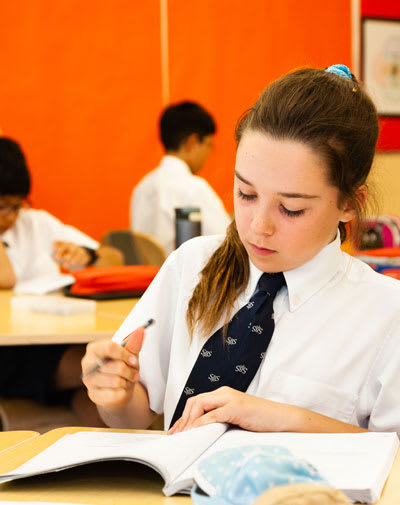
Athletics and extracurricular activities
As phys-ed teacher Chris Woodward leads us to the school’s gym, he stops short of going into the space, which is obviously smaller than average. Instead, we stand in the hallway outside, which is covered with photos of students engaged in all types of sports and activities. A closer look reveals that they’re in multiple venues outside the school.
“Our students don’t miss out on anything because of our small size,” Woodward says. “In fact, they probably participate in a wider range of activities than students at many larger schools.” Starting in Grade 3, the children go off-site to take advantage of the rich opportunities in the local community. From curling, martial arts and rock climbing to swimming, tennis and gymnastics—it’s all a short bus ride away, and all covered by tuition.
For the younger students, the gym is big enough to give them a traditional phys-ed program. Classes run three days out of five for all students, supplemented by 60 minutes of daily unstructured activity on the playground. “Our goal is to give students an introduction to all the major sports and activities, as well as a solid grounding in sportsmanship and team work,” says Woodward. “We’re building their confidence by making it fun, and educating them on the importance of lifelong fitness.”
It’s such a small school that you’re not afraid to lose at sports here,” says one Grade 4 student, whose peers quickly remind her that she never loses when she’s running track. “But if you did, nobody is going to make you feel bad about it,” she retorts.
It appears to be true, since many of the kids we spoke to report being part of some kind of athletics. There are school teams for basketball, cross country, soccer, softball, and track and field. They practice at nearby fields and courts, and the trophies suggest they have great success at tournaments run by the Small Schools Athletic Federation. Merton the Wizard is the team mascot, and parent attendance at tournaments is high.
Starting in Grade 1, students can join school clubs ranging from chess, Lego and robotics to choir, yoga and sewing. More than three-quarters of students opt to join at least one of the clubs, which are run by teachers and community-based organizations.
But the signature extracurricular event is the annual spring musical. Leading up to the big event, set pieces and costumes sit in wait, and the sounds of rehearsal fill the building after school. Past performances have included Annie, Willie Wonka, Aladdin and The Wizard of Oz, and this year’s production is Madagascar.
Whether centre-stage or behind-the-scenes, there’s a role in the show for every child from Grade 1 to Grade 6. There’s also a job for every faculty member in putting on the elaborate production, with principal Teralee Brunn coordinating and directing the choreography. It’s all hands on deck, but the results—according to everyone we spoke to—are worth it.
“They do a truly incredible job,” says one parent with two students at the school. “We’re always amazed by what they pull off in the end, and by how much work the staff puts into the production. The kids get so excited about it too.” The whole experience of the musical is, in effect, an extra unit of inquiry that shows students how to express themselves through collaboration, drama, music and performance, says Brunn.
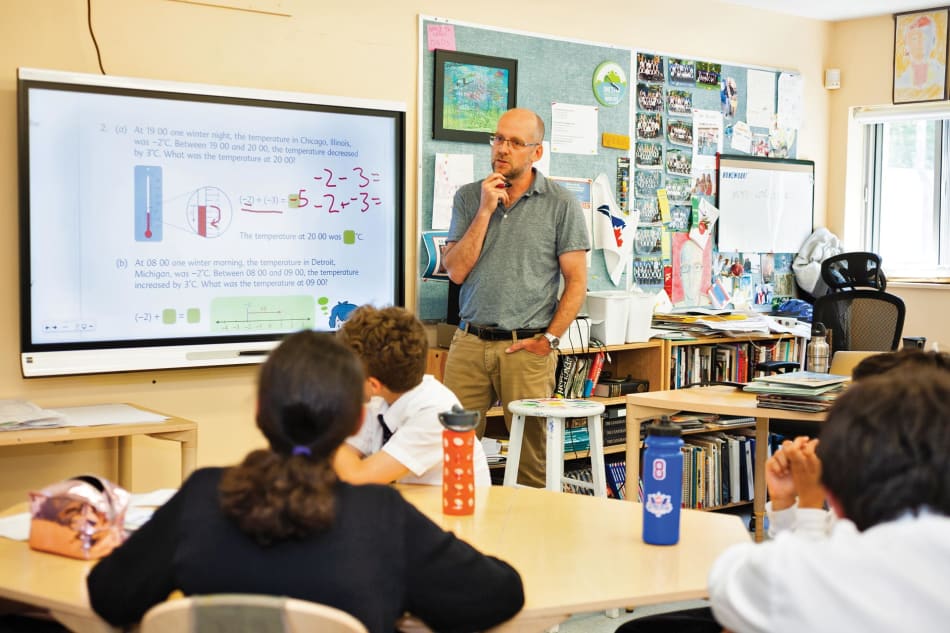
Pastoral care
While the school’s small size means there’s no guidance counsellor devoted to students’ non-academic well-being, the faculty’s dedication to creating a warm, nurturing, affectionate learning environment is evident and echoed by parents. “The kids feel cared for here,” says the parent of students in Grade 3 and Grade 6. “It’s as simple as that. And we feel our kids are known and cared for.”
“The children’s emotional, creative and social needs are just as important here as their academic needs,” says Davy. The expectations are high when it comes to being respectful and responsible, and when students don’t meet them, they’re expected to reflect on what went wrong in writing. “Instead of just saying ‘sorry,’ they have to sit back, think about what they did, and talk to a teacher and reflect on the incident,” says one parent. “By the end of the process, they’re calm and have a better understanding of how to do better next time.”
The positive discipline approach preserves children’s self-esteem while reinforcing the requirements of good citizenship, says Brunn. “It’s about developing empathy and ensuring everyone feels valued.” One of Brunn’s priorities for the first year of her principalship is to put student wellness and mental health in the spotlight with more formal, school-wide programs, educational initiatives and activities.
Transition to Grade 7
Applying to middle school is a major milestone in the lives of Grade 6 students and their families, but none of the people we spoke to expressed any anxiety about the process. It’s proof of how fully, thoughtfully and carefully SBS prepares students for the next step.
“I remember my husband and I were sitting outside the office where our daughter was doing her admissions interview, and we kept looking at each other in amazement,” says the parent of a graduate. “She sounded so poised and mature. They coach them so well here that we didn’t have to worry about anything.”
The faculty takes an active role helping parents search for a new school: offering individualized guidance based on their child’s strengths, and aiding with students’ interviews and test prep. In the end, 95% to 100% of students get accepted into their school of choice in Grade 7.
“There’s so much confidence-building along the way,” says another parent of a graduate. “Everyone has a voice and feels important, so by the time they get to Grade 6 they’re ready to go.” There are ongoing leadership opportunities throughout the grades via house activities, the weekly assembly, the spring musical, community service and sports events. Starting in Grade 4, students pair up with JK students and meet weekly over three years as part of the Learning Buddies program, which goes beyond reading assistance to a broader mentoring relationship.
“By Grade 6, our students have a lot of responsibility,” says Brunn. “They run the assemblies, they’re house heads, they give parent tours—it’s all preparation for success in what’s ahead. And they do succeed. The schools want our kids.”
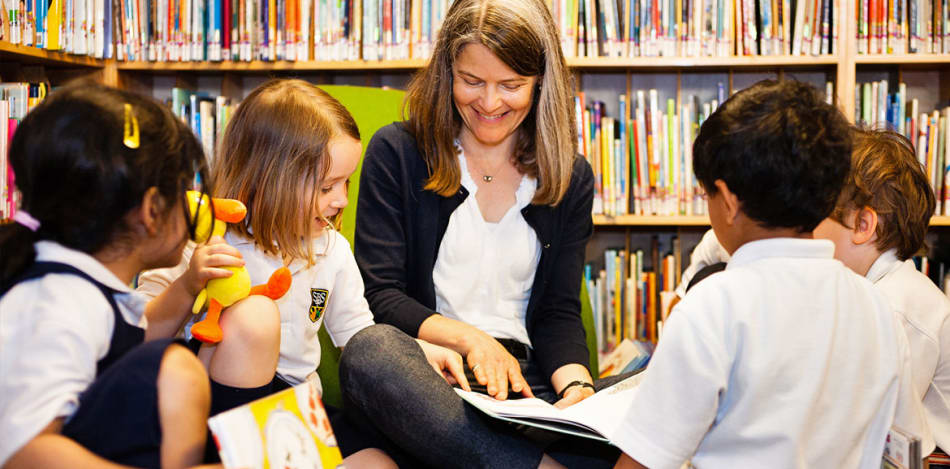
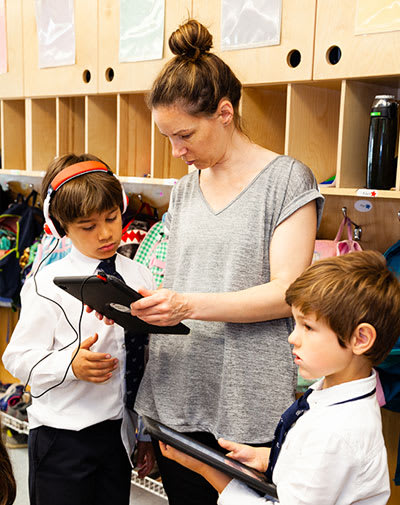
Getting in
With its strong emphasis on setting young students up for future success and building confidence, the school is careful to only select children who can keep pace with the enriched IB curriculum. Families can apply for all grades throughout the year, though there may not always be space. The application process includes an online form (accompanied by the two most recent report cards, if the student is not entering in kindergarten) and parent and student interviews. The student interviews generally involve groups of two to four applicants, and there is often time spent in the classroom of their current grade.
“We do an assessment of the children where we stretch them and see if they can stretch with us,” says Brunn. “If they can’t, even if we have space available, we recommend other schools. If a child isn’t going to be successful with our curriculum, then it’s not the best fit. For one thing, it’s not good for their self-esteem.” The school encourages prospective families to see SBS in action by attending an open house or scheduling a tour.
Money matters
SBS is competitively priced with other private schools in the Greater Toronto Area. The application process includes an enrolment application fee, a one-time registration fee, a tech fee, a parents’ association fee, tuition, trips costing less than $25 and the daily lunch program (as well as daily snacks, or “tea,” for kindergarten students). Optional fees include daily or occasional after-care, learning support and big-ticket trips. Parents can pay for the full year of after-care or opt for occasional after-care, invoiced monthly. Parents report that the fees are clear and well presented, and that there are no surprises after the fact or throughout the school year.
Parents and alumni
“The school wants us to be involved,” says the former president of the parents’ association. “We’re welcomed and encouraged to be here.” On the other hand, the parents we spoke to agree that there are no expectations or unwritten quotas in terms of families’ volunteer commitments. “The nice thing about Sunnybrook is that there’s a variety of parents. Some work very demanding jobs, and some don’t work. Everyone understands that, and gets that it determines how much time people can contribute.”
A key benefit of the school’s small size, says another parent, is that there’s very little red tape to get through when it comes to parent-initiated projects. “If we raise money for something in the school and we want it done, it gets done. We also get asked for our feedback a lot, and it feels like we’re listened to.”
Parents are included in several special events over the school year, ranging from a family movie night to parents’ association speaker nights. At the year-end wine and cheese/student art show, there’s formal recognition for every volunteer—whether they were at the school every week, or on one field trip.
According to the current president of the parents’ association, the association is refreshingly free of cliques. “Everybody feels included, and kids feel that their parents are part of their school, which is good for everybody.” Teacher Jayne Hamilton says it’s easy to form close parent-teacher relationships in a small school, which enriches the whole community. “It’s very much an open-door policy for parents.”
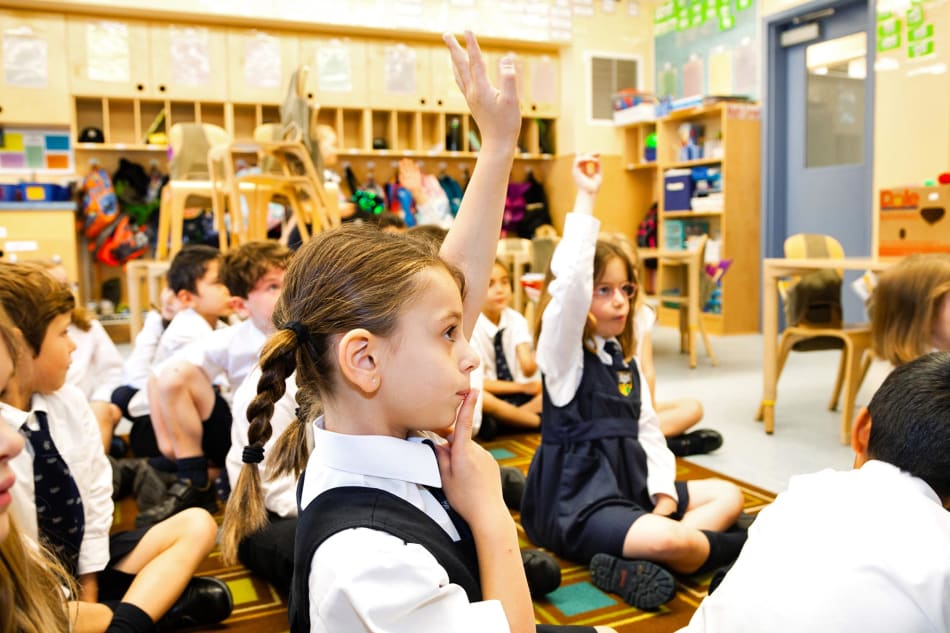
The takeaway
Each year, the Grade 6 students deliver a brief speech at their graduation celebration. Director Irene Davy has heard hundreds of them over more than three decades at the school, and one thing stands out: “They almost always say they’ve been happy here.”
SBS is a happy place—a small, cozy, academically enriched community of young learners in the care of dedicated teachers. It’s not fancy, but it’s also not pretentious. The emphasis on balance preserves the fundamentals while incorporating the latest evidence-based approaches, and it nurtures students’ confidence while encouraging them to test their limits. Every child is known not just by their teacher, but by all the teachers and students.
“We’re all about providing the best possible learning experience in the elementary years,” says Davy. “Learning how to be a better member of the community, how to be social on the playground, how to be a leader and, maybe most important, learning how to learn and enjoy it.”


